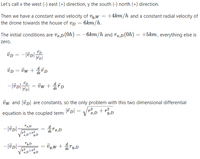Let's say we have a long-range helicopter drone. With this drone, we want to carry a small package to our home. Let's assume that initially the drone was 5 km east of our home. The purpose of the drone will be to fly directly to our house. For this reason, we program the drone to return directly home at a speed of 6 km per hour. Meanwhile, there is a wind blowing from the south at a speed of 4 km per hour. But the drone is always pointing straight to the house. Assuming that the drone always flies at the same height:
1. Obtain the mathematical model that gives the drone's flight path (route) and solve this model using the appropriate analytical method you have learned / will learn in this lesson. (Hint: This model will be a system of ordinary differential equations that can be conveniently reduced to a single ordinary differential equation.)
2. Using the given numerical values (as well as some different values you will give yourself), draw a graph of the drone's journey from the departure location to the home using a computer program.
1. Obtain the mathematical model that gives the drone's flight path (route) and solve this model using the appropriate analytical method you have learned / will learn in this lesson. (Hint: This model will be a system of ordinary differential equations that can be conveniently reduced to a single ordinary differential equation.)
2. Using the given numerical values (as well as some different values you will give yourself), draw a graph of the drone's journey from the departure location to the home using a computer program.

